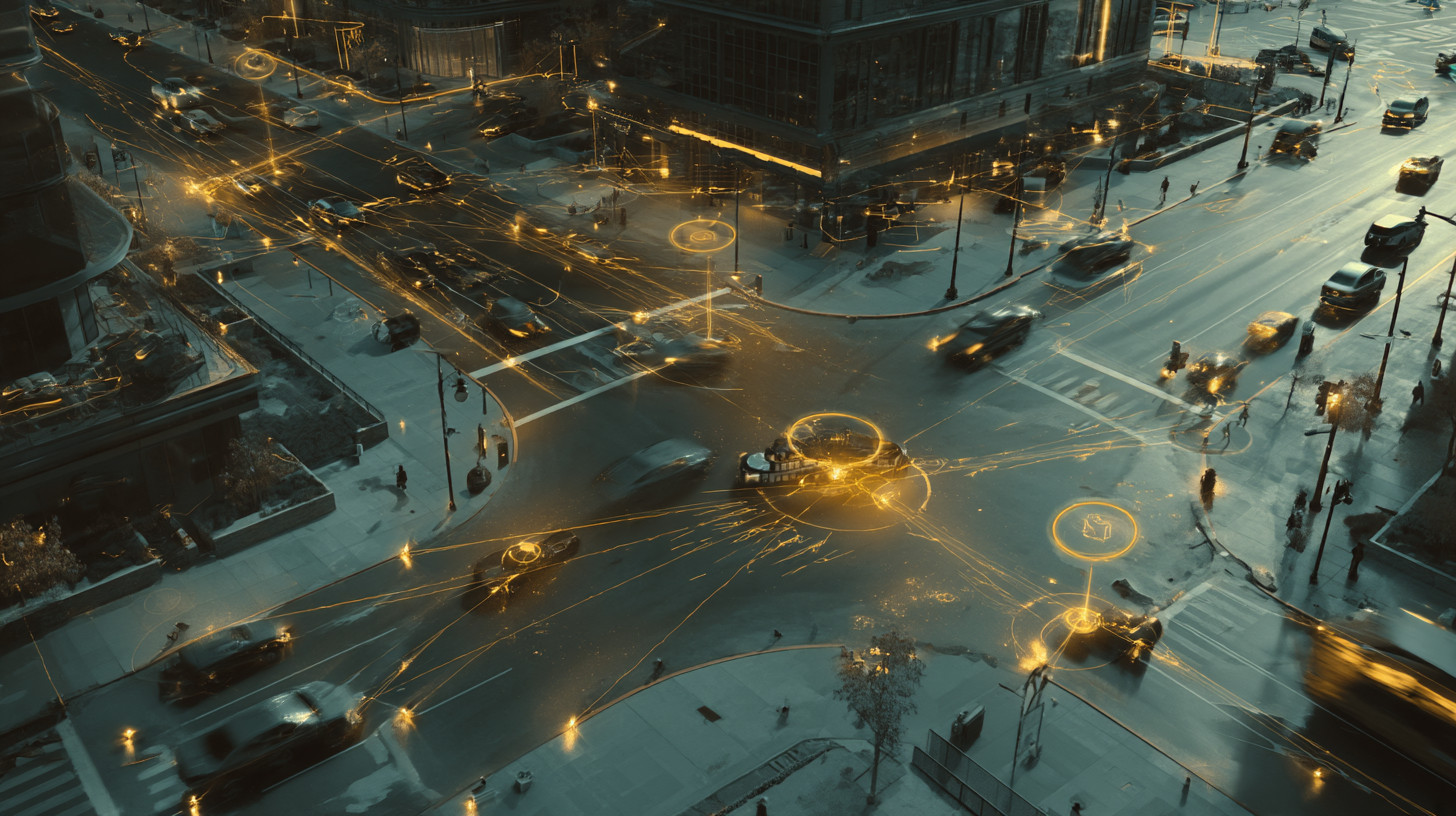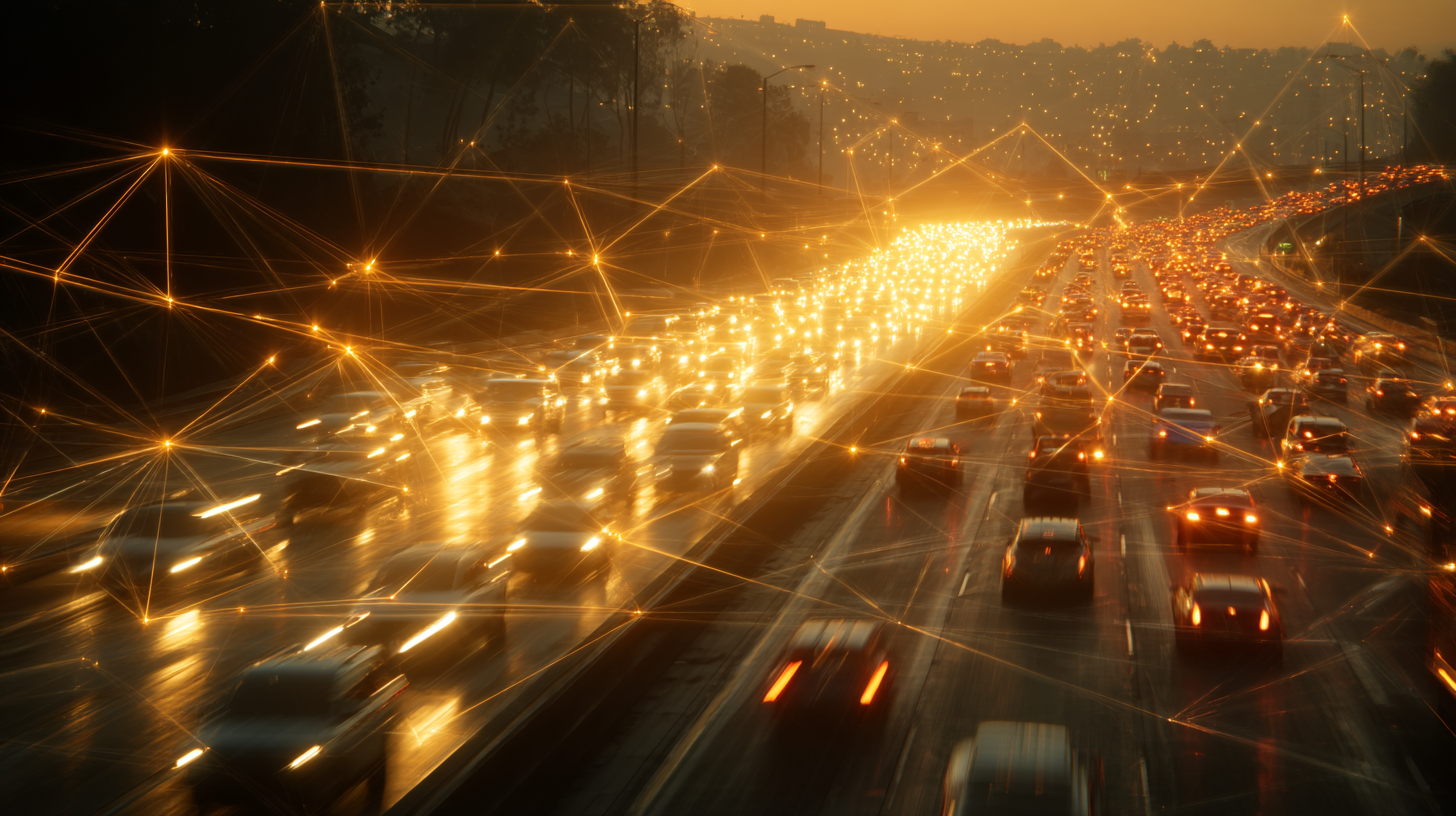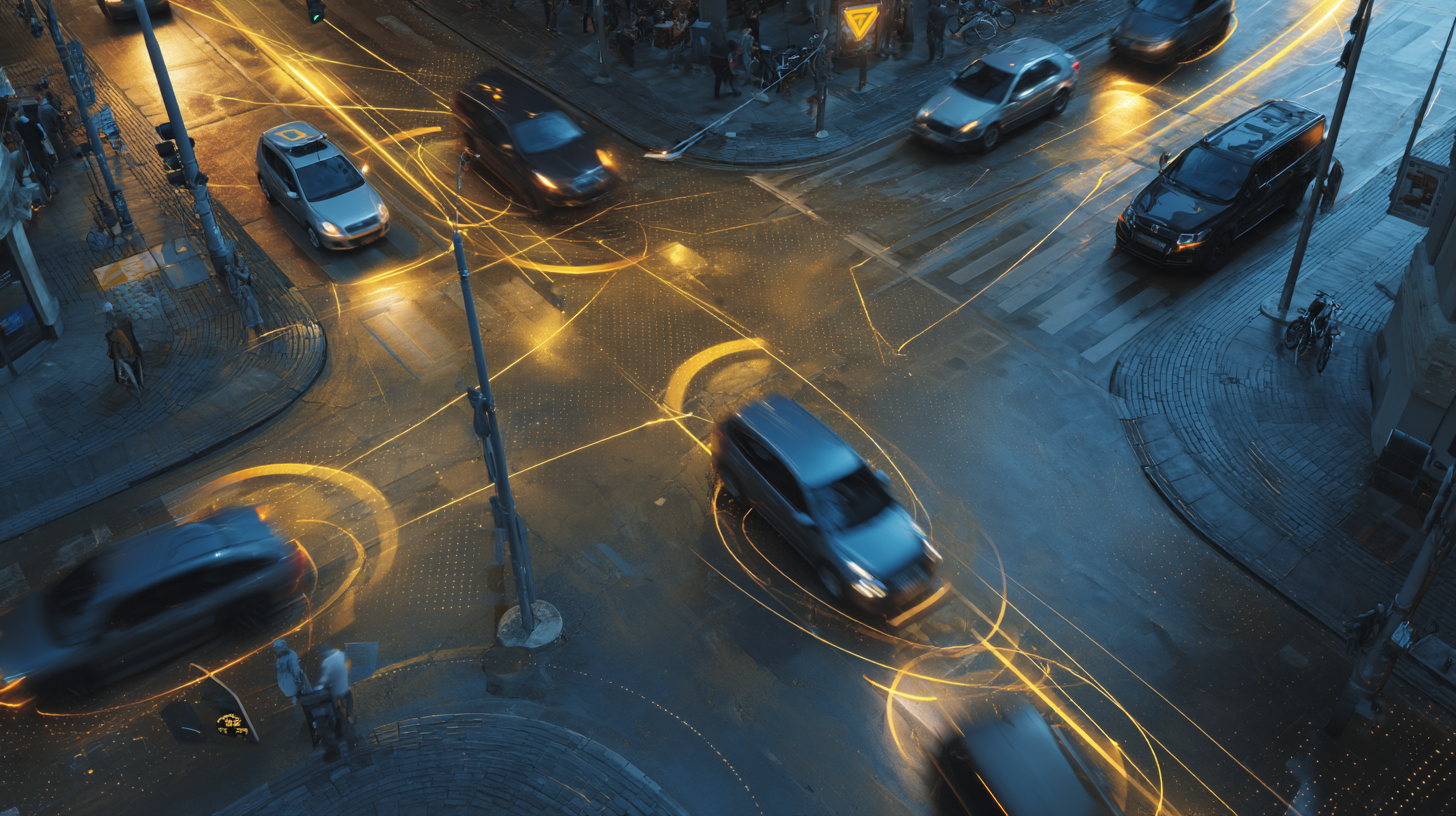By 2043, Vehicle Communication Orchestrates Traffic into a Single Intelligent Organism #Trend
Explore the Transportation trend of Vehicle-to-Vehicle (V2V) communication. This article predicts how V2V creates traffic as an intelligent organism by 2043, detailing C-V2X's role & future evolution. Uncover this mobility transformation.

Forget everything you know about roads, about traffic, about vehicles as isolated metal boxes. By 2043, we are witnessing a radical transformation: Vehicle-to-Vehicle (V2V) communication will have orchestrated global traffic flows into something previously unimaginable; a single, intelligent, hyper-connected organism. This is not an evolution of transportation; it is the genesis of a kinetic consciousness on our highways. 🤯 #FutureOfMobility
At Trend Horizon, we assert that V2V is the nascent nervous system for sentient mobility, building a collective awareness that sees beyond human capacity and traditional sensor limits. It promises an era of unprecedented safety, fluidity, and efficiency, underpinning a future where our vehicles don't just drive; they converse, cooperate, and choreograph. We analyze this seismic shift through the lens of Trend Horizon's "V2V Nexus Model", revealing its foundational power. 🚀 #V2VRevolution
How did this invisible network come to be, and what critical junctures defined its path? In this definitive Trend Horizon exploration, we will dissect the origins of V2V communication, reveal the complex dynamics of its present landscape, and paint a detailed, visionary picture of the future it is actively constructing, right up to the point it becomes an integral part of our conscious cities. 🧭
Ready to understand the invisible forces that will redefine movement itself and shape the urban landscapes of tomorrow? Step with us into the past, navigate the present, and boldly forecast the electrifying future of Vehicle-to-Vehicle Communication. Let the journey begin. 💡 #TrendHorizon
I. Vehicle-to-Vehicle Unveiled: The Invisible Network Forging Vehicular Dialogue 🔗📡 #TrendExplained
At Trend Horizon, we decode V2V communication not merely as a feature, but as a foundational technology forging an intricate, invisible network between moving vehicles. It empowers them to engage in direct, wireless dialogue, continuously exchanging critical operational data. To illuminate its architecture and essence, we view V2V through Trend Horizon's "V2V Nexus Model", which focuses on its core principle of direct dialogue, its Ecosystem Context within V2X, the Enabling Technologies that form its backbone, and its Functional Blueprint for smarter mobility. 🧐
Core Principle: Direct Vehicular Dialogue, Functionality, and Strategic Objectives
The core principle of V2V communication technology is the facilitation of direct, wireless communication between vehicles. This empowers them to exchange real-time data packets containing information such as their speed, precise location, direction of travel, braking status, and even turning intentions. This form of communication is distinct from other types of vehicular communication, such as Vehicle-to-Network (V2N) or Vehicle-to-Infrastructure (V2I), as its primary focus is on peer-to-peer exchange between vehicles themselves.
In terms of functionality, vehicles equipped with V2V systems continuously broadcast and receive messages. These messages, often referred to as Basic Safety Messages (BSMs), are updated and transmitted multiple times per second. This constant exchange allows vehicles to form a dynamic ad-hoc network, often described as a mesh network, with other V2V-enabled vehicles in their vicinity. Such a network grants each vehicle a 360-degree awareness of its immediate traffic environment. Crucially, this awareness often extends beyond the driver's line of sight or the detection range of the vehicle's onboard sensors, such as cameras, and radar (LiDAR).
The strategic objectives underpinning the development and deployment of V2V communication are multifaceted.
- The foremost objective is to enhance road safety by preventing or mitigating traffic accidents; bodies like the National Highway Traffic Safety Administration (NHTSA) in the United States have noted its potential to address a significant percentage of multi-vehicle incidents.
- Secondly, V2V aims to improve traffic efficiency by reducing congestion and optimizing traffic flow.
- Thirdly, it serves as a critical supporting technology for the development and refinement of advanced driver-assistance systems and, ultimately, fully autonomous driving capabilities.
The overarching goal is to foster a more cooperative, predictable, and safer driving environment. The information exchanged is not static; while Basic Safety Messages containing fundamental vehicle dynamics are key, the list of potential data points shared between vehicles is expected to expand as the technology matures and new applications emerge. 🛣️

Ecosystem Context: V2V's Role in the V2X Symphony
Understanding V2V also means situating it within the broader ecosystem context of Vehicle-to-Everything (V2X) communication. V2X serves as the comprehensive umbrella term for systems that allow vehicles to interact with various elements within their operational environment. V2V is a critical and foundational component within this broader ecosystem, which encompasses several distinct yet interconnected communication modes, each with specific roles that complement V2V:
- Vehicle-to-Infrastructure (V2I): This involves communication between vehicles and fixed roadside infrastructure, such as traffic signals 🚦, electronic road signs, and dedicated Roadside Units (RSUs). V2I provides vehicles with broader situational awareness, relaying information like traffic Signal Phase and Timing (SPaT), work zone warnings, or hazard alerts originating from the infrastructure itself. This complements V2V's localized vehicle-centric data by adding contextual information from the road network.
- Vehicle-to-Pedestrian (V2P): This mode facilitates communication between vehicles and Vulnerable Road Users (VRUs) like pedestrians and cyclists, often through their smartphones or wearable devices. V2P aims to enhance the safety of VRUs by alerting drivers to their presence, especially in situations with limited visibility, and vice versa.
- Vehicle-to-Network (V2N): V2N enables communication between vehicles and wider network services, such as cloud platforms, typically via cellular networks like 4G LTE and 5G. This mode allows vehicles to access real-time data for navigation updates, weather information, infotainment services, and can facilitate longer-range communication.
- Vehicle-to-Cloud (V2C): Often considered a subset of V2N, V2C specifically focuses on the exchange of data between vehicles and cloud-based servers for extensive processing, analysis, and service provision (e.g., OTA updates).
- Vehicle-to-Device (V2D): A broader category encompassing interactions between vehicles and various other connected devices, including smartphones or smart home systems.
- Vehicle-to-Grid (V2G): Specific to electric vehicles (EVs), V2G communication allows EVs to interact with the electrical grid for smart charging and potentially discharging power back to the grid.
These V2X components are designed to work synergistically. Within this interconnected ecosystem, V2V's unique contribution lies in its ability to provide the most immediate, low-latency information about the dynamic state of surrounding vehicles. This is paramount for time-sensitive safety applications like imminent collision avoidance, where the direct, peer-to-peer nature of V2V offers a speed and specificity that other V2X forms might not match. V2V effectively creates a Non-Line-Of-Sight (NLOS) sensor capability, fundamental to its value proposition. #V2X #Connectivity
| Component | Primary Function | Key Technologies Used | Typical Applications | Synergy with V2V |
|---|---|---|---|---|
| V2V | Direct communication between vehicles | DSRC, C-V2X (PC5) | Collision avoidance, cooperative adaptive cruise control, platooning, emergency alerts (sudden braking, hazards) | Provides core, low-latency data on surrounding vehicles, forming the basis for many cooperative safety and efficiency applications. |
| V2I | Communication between vehicles and roadside infrastructure (e.g., traffic lights, RSUs) | DSRC, C-V2X (PC5/Uu) | Traffic signal optimization, work zone warnings, speed advisories, road hazard alerts from infrastructure | Complements V2V with contextual road network information; V2V data can inform V2I systems for traffic management. |
| V2P | Communication between vehicles and pedestrians/cyclists (VRUs) | DSRC, C-V2X (PC5), Wi-Fi, BT | VRU safety alerts, collision warnings for pedestrians/cyclists | Enhances V2V safety by adding awareness of non-vehicular road users; V2V detection can be fused with V2P data. |
| V2N | Communication between vehicles and cellular networks/cloud platforms | Cellular (4G LTE, 5G), C-V2X (Uu) | Real-time traffic updates, navigation, infotainment, remote diagnostics, OTA updates, emergency call (eCall) | Provides wider area connectivity, can relay V2V/V2I messages, enables cloud-based processing of V2V data for broader services. |
| V2C | Vehicle communication specifically with cloud-based servers for data processing and service delivery | Cellular (4G LTE, 5G), Wi-Fi | HD map updates, advanced traffic analytics, remote vehicle services, data aggregation for smart city applications | Cloud platforms can process aggregated V2V data for large-scale traffic analysis and prediction, feeding insights back to vehicles via V2N. |
| V2D | Communication between vehicles and various external devices (e.g., smartphones, smart home systems) | Wi-Fi, Bluetooth, Cellular | Personalized in-car experiences, remote vehicle control via apps, integration with smart home ecosystems | Can leverage V2V status information for device-specific notifications or actions. |
| V2G | Communication between electric vehicles and the power grid | PLC, Wi-Fi, Cellular | Smart charging, demand-response programs, vehicle-to-home power, grid stabilization services | V2V-derived traffic flow predictions could potentially inform V2G charging strategies to optimize grid load. |
Enabling Technologies: The Wireless Backbone
The functionality of V2V communication hinges on specialized wireless technologies designed for demanding vehicular environments. Two primary technology families have emerged: Dedicated Short-Range Communications (DSRC) and Cellular V2X (C-V2X). The evolution towards 5G and future network generations is set to further enhance these capabilities. 📡
- Dedicated Short-Range Communications (DSRC), based on the IEEE 802.11p standard (an adaptation of Wi-Fi), operates in dedicated spectrum (e.g., 5.9 GHz band) for direct V2V and V2I links independent of cellular infrastructure. It's engineered for robustness in high-speed environments, with typical ranges around 300 meters, extendable via multi-hop. Standardized around 2010, DSRC has been extensively tested and formed the basis for early V2X deployments.
- Cellular V2X (C-V2X), standardized by 3GPP, leverages cellular technology. C-V2X uniquely offers dual modes: the PC5 interface (Sidelink) for direct, low-latency V2V, V2I, and V2P communication even without network coverage, and the Uu interface for V2N communication via cellular networks. C-V2X boasts a clear evolution path aligned with 5G, potentially offering longer ranges and superior performance in non-line-of-sight conditions. Initial specifications focused on LTE-V2X, while later releases (starting with Release 16) introduced 5G New Radio (NR) based V2X, promising further enhancements.
Further bolstering these capabilities, particularly for C-V2X, are 5G networks. 5G isn't just faster; it provides specific attributes vital for sophisticated V2V operations. These include Ultra-Reliable Low-Latency Communication (URLLC), critical for instantaneous safety responses; Enhanced Mobile Broadband (eMBB) for high-throughput data needs like sensor sharing; and Massive Machine-Type Communication (mMTC) to support a vast number of connected vehicles. Features like network slicing and mobile edge computing (MEC) further enhance 5G's ability to provide a robust platform for complex V2V functionalities. It’s the nervous system for a truly connected vehicular ecosystem. 🧠 #5G #FutureNetworks
Looking further ahead, future network generations like 6G and 7G are expected to push the boundaries of V2X capabilities even further, enabling highly sophisticated, immersive, and intelligent V2X applications, forming the communication backbone of a truly ubiquitous and cooperatively autonomous transportation society.
| Feature | DSRC (IEEE 802.11p) | C-V2X (LTE-V2X & 5G NR-V2X) |
|---|---|---|
| Standard Basis | IEEE 802.11p (WAVE), ETSI ITS-G5 | 3GPP Releases (Rel. 14/15 for LTE-V2X, Rel. 16+ for 5G NR-V2X) |
| Operating Frequency | Primarily 5.9 GHz ITS band | 5.9 GHz ITS band (PC5), cellular bands (Uu), other potential bands for PC5 |
| Typical Direct Range | ~300m, up to 1km+ (mesh/ideal conditions) | PC5: Similar to or slightly better than DSRC; Uu: Cellular network coverage dependent |
| Data Rates | 3-27 Mbit/s | LTE-V2X: Tens of Mbps; 5G NR-V2X: Potentially Gbps+ |
| Latency (Direct Comm.) | Low (few milliseconds) | LTE-V2X PC5: Low (comparable to DSRC); 5G NR-V2X PC5: Ultra-low (<1ms targeted) |
| Key Advantages | Mature, extensively tested, no network dependency | Evolution path to 5G/6G, potential for better NLOS, scalability with network, dual-mode (PC5/Uu) versatility |
| Limitations | Limited evolution path, potential spectrum congestion | Newer than DSRC (less long-term real-world data for early versions), network dependency for Uu features |
| Primary Applications | Safety (collision warning, hazard alerts), V2I | Safety, advanced ADAS/AV features, infotainment, telematics (broader scope with Uu) |
| Path to 5G/Future Nets | Limited direct path; separate technology | Direct evolution path within 3GPP cellular standards |
| Current Deployment Lean | Legacy in some regions (e.g., early EU, Japan ITS Connect); US phasing out | Gaining dominance globally, strong backing in US, China, and increasingly EU |
Functional Blueprint: Capabilities Unlocked
V2V's Functional Blueprint details what this technology is inherently designed to achieve. The real-time data exchange forms the bedrock for a suite of transformative applications. Foremost is its potential to drastically improve road safety. By enabling vehicles to "talk" to each other, a new layer of awareness is created for proactive collision avoidance systems, capable of issuing warnings for potential forward collisions, unsafe intersection entries (Intersection Movement Assist - IMA), or risky lane changes (Lane Change Warning/Blind Spot Detection) by understanding the state of nearby vehicles. V2V also allows vehicles to broadcast warnings about immediate dangers like sudden braking (Emergency Electronic Brake Light - EEBL) or road hazards. This dramatically enhances situational awareness, allowing vehicles to metaphorically 'see' around corners or through obstructions—a capability fundamental for robust decision-making in safety-critical situations for both ADAS and fully autonomous systems.
V2V also underpins traffic efficiency applications. It provides rich, real-time data that, when aggregated (often via V2I/V2N), allows for traffic flow optimization and dynamic traffic signal timing. V2V enables vehicle platooning - where vehicles travel in closely coordinated convoys to reduce aerodynamic drag and save fuel - and facilitates coordinated merging and lane changes. For Autonomous Vehicles (AVs), V2V is integral for cooperative perception (sharing sensor data for a richer environmental model) and coordinated maneuvering, facilitating smoother, safer navigation. This fusion of onboard sensor data with V2V information allows for a much richer and more reliable understanding of the environment, acting as a crucial sense for both human-driven and autonomous mobility. The demands of higher-level autonomy (L4/L5) necessitate the exchange of vast amounts of sensor data for collective perception and real-time coordination of highly complex maneuvers, capabilities that 5G and future networks are designed to support. 🛡️ #SmartMobility #SafetyFirst

II. Tracing the Tracks: The Story of Vehicle-to-Vehicle Communication 🗺️🚗 #TrendHistory
When we look back, the dream of cars communicating with each other isn't brand new. The conceptual underpinnings of V2V communication can be traced to ambitious Automated Highway System (AHS) projects from the 1970s, gaining more traction in the 1990s. Programs like the Electronic Route Guidance System (ERGS) in the United States and Japan's Comprehensive Automobile Traffic Control System (CACS) explored vehicle automation and how inter-vehicle coordination could improve traffic, laying crucial groundwork. A more direct focus on inter-vehicular communication for safety and efficiency crystallized in the early 2000s. The Vehicle Infrastructure Integration (VII) initiative in the United States, launched around 2003, marked a significant turn, formally commencing research into what would become V2V communication systems. This was the point where the potential of direct vehicle-to-vehicle data exchange started to get serious recognition, with academic institutions and research bodies diving deep into its feasibility. #V2Vorigins #SmartRoads
As V2V's potential benefits became clearer, the hunt was on for a dedicated, standardized communication technology. Enter Dedicated Short-Range Communications (DSRC). Driven largely by the U.S. Department of Transportation (USDOT), DSRC built upon earlier international efforts. The real cornerstone of DSRC became the IEEE 802.11p standard. An IEEE task group was formed in November 2004 to adapt the existing Wi-Fi standard for the challenging environment of moving vehicles (Wireless Access in Vehicular Environments, or WAVE). After years of drafting, this standard was officially published on July 15, 2010. A huge step forward was the U.S. Federal Communications Commission (FCC) allocating 75 MHz of spectrum in the 5.9 GHz band specifically for Intelligent Transportation Systems (ITS), with DSRC as the star player. Europe soon followed suit with similar allocations and the ETSI ITS-G5 standard. The U.S. National Highway Traffic Safety Administration (NHTSA) championed DSRC-based V2V, conducting over a decade of research. In August 2014, NHTSA released an influential report highlighting V2V's life-saving potential and signaling a possible mandate for the tech in new vehicles. This led to large-scale pilot programs in cities like New York, Wyoming, and Tampa, and early DSRC deployments by automakers such as Toyota and Volkswagen (with its ITS-G5). 🚦 #DSRC #SafetyFirst
A New Challenger Appears: The C-V2X Revolution
Just as DSRC was hitting its stride in pilot programs, a new contender emerged from the cellular industry: Cellular V2X (C-V2X). Spearheaded by companies like Qualcomm, the idea was to leverage existing and future cellular networks, offering a potentially more advanced and globally integrated roadmap. The standardization baton for C-V2X was picked up by the 3rd Generation Partnership Project (3GPP). Their work, starting around 2014, culminated in the 2017 finalization of 3GPP Release 14, which officially introduced LTE-based C-V2X. This was a pivotal moment, establishing C-V2X as a serious contender. Subsequent releases, like Release 15 and notably Release 16 in June 2020, pushed the envelope further, defining specifications for 5G New Radio (NR)-based V2X, promising ultra-low latency and high reliability for even more advanced applications. To champion this new tech, the 5G Automotive Association (5GAA) was founded in September 2016 by a coalition of heavy-hitters from the automotive and telecom worlds. 📣 #CV2X #5GAA
What followed was an intense period of competition, often dubbed the "standards war", between DSRC and C-V2X. It wasn't just about which tech was better on paper; it reflected different strategic visions from two major industrial ecosystems. Some automakers, like Ford, even switched allegiances from DSRC to C-V2X, citing its 5G evolution path. China made an early and decisive commitment to C-V2X. Then, in a landmark decision in November 2020, the U.S. FCC voted to reallocate a significant portion of the 5.9 GHz band, dedicating the upper 30 MHz exclusively to C-V2X technologies. This move effectively signaled a major shift in momentum towards C-V2X in the United States, highlighting how the promise of leveraging the rapidly evolving cellular ecosystem could reshape the future of connected vehicles. The allure of a globally standardized, future-proof path proved compelling. 🌐 #TechEvolution #ConnectedCars
| Era/Year | Significant Event/Initiative | Key Organizations/Actors Involved | Impact on V2V/V2X Trajectory |
|---|---|---|---|
| 1970s-1990s | Early research on Automated Highway Systems (AHS) | Various national transport research bodies (US, Japan, Europe) | Laid conceptual groundwork for vehicle automation and inter-vehicle coordination. |
| 1999 | DSRC noted as the sole enabling V2X technology at the time | Early V2X proponents | Established DSRC as the initial technological path for V2X. |
| 2003 | Vehicle Infrastructure Integration (VII) initiative launched in the US, beginning formal V2V research | US Department of Transportation (USDOT) | Focused research efforts specifically on V2V and V2I communication for safety and mobility. |
| Nov 2004 | IEEE 802.11p Task Group formed to develop WAVE standard for vehicular environments | IEEE | Initiated formal standardization process for DSRC's physical and MAC layers. |
| Aug 2008 | European Commission allocates part of the 5.9 GHz band for ITS safety applications (basis for ITS-G5) | European Commission | Secured dedicated spectrum for DSRC-based V2X in Europe, fostering regional development. |
| Jul 2010 | IEEE 802.11p standard published ("Amendment 6: Wireless Access in Vehicular Environments") | IEEE | Provided the official, internationally recognized standard for DSRC technology. |
| 2010 | EU Intelligent Transport Systems (ITS) Directive adopted | European Union | Provided a legal framework for the coordinated deployment of ITS, including V2X, in Europe. |
| Aug 2014 | NHTSA issues ANPRM and research report on V2V readiness; 3GPP begins Rel-13 studies for C-V2X | NHTSA, 3GPP | Signaled potential US mandate for V2V (DSRC-based at the time); initiated cellular industry's formal work on V2X. |
| 2016 | C-Roads platform launched in Europe for harmonized C-ITS deployment; 5GAA founded | European Member States, European Commission, 5GAA founding members | Accelerated practical deployment and interoperability testing of V2X in Europe; created a powerful industry alliance to advocate for C-V2X globally. |
| Mar 2017 | 3GPP Release 14 specifications for C-V2X (LTE-V2X) finalized | 3GPP | Established C-V2X as a standardized alternative to DSRC, with defined direct (PC5) and network (Uu) communication modes. |
| Jun 2020 | 3GPP Release 16 specifications for 5G NR-V2X completed | 3GPP | Introduced 5G-native V2X capabilities, promising enhanced performance for advanced applications and autonomous driving. |
| Nov 2020 | US FCC reallocates 5.9 GHz spectrum, dedicating upper 30 MHz to C-V2X | US Federal Communications Commission (FCC) | Major policy shift in the US, effectively favoring C-V2X over DSRC for future ITS deployments and significantly impacting DSRC's viability in the US market. |
| 2020 onwards | First commercial C-V2X deployments, notably in China; continued pilot programs globally | OEMs, Infrastructure Operators, Governments | Transition from R&D and pilots to initial commercialization and larger-scale deployments of V2X technology. |
| Aug 2024 | US DOT releases National V2X Deployment Plan | USDOT | Provides a strategic roadmap and goals for accelerating nationwide V2X deployment in the US, focusing on C-V2X. |

III. Vehicle-to-Vehicle Communication's Current Crossroads: Momentum Meets Real-World Complexities 🚗⚙️ #TrendInMotion
In its current chapter, V2V communication, a cornerstone of the broader Vehicle-to-Everything (V2X) vision, is undeniably transitioning from well-studied blueprints to the grittier reality of initial commercial rollout. At Trend Horizon, we observe a dynamic landscape energized by an urgent quest for enhanced road safety, the escalating capabilities of Advanced Driver-Assistance Systems (ADAS), the inexorable advance of autonomous driving ambitions, and burgeoning smart city initiatives. This shift is characterized by palpable momentum, yet it's also a period deeply entangled with significant, real-world complexities that define its present trajectory. 📈 #V2VNow #ConnectedMobility
The global V2X market, with V2V at its core, is broadcasting strong signals of robust growth. While specific market size figures vary, consistent projections show substantial double-digit expansion; for example, some estimate the V2V market around $24-28 billion in 2024. However, at Trend Horizon, we find the real narrative lies beneath these headline numbers: it's in the compelling 'why now?'. This expansion is critically fueled by non-negotiable road safety imperatives, amplified by governmental nudges towards smarter, safer transport, the pressing need to untangle urban congestion, and significant technological leaps, especially the accelerating capabilities of Cellular V2X (C-V2X) in synergy with 5G networks. These forces are not just statistics; they are the powerful undercurrents shaping V2V's present reality. 📊 #V2XGrowth #MarketForces
The Decisive Technological Current: C-V2X's Rise and Regional Realities
A defining feature of V2V's current landscape is the intensifying, and many argue concluding, contest between Dedicated Short-Range Communications (DSRC) and Cellular V2X (C-V2X). Our analysis at Trend Horizon indicates C-V2X is not merely gaining traction but achieving global ascendancy. This is starkly evidenced in pivotal markets: the United States, with the FCC decisively allocating the 5.895–5.925 GHz band to C-V2X (and the US National V2X Deployment Plan of August 2024 targeting ambitious 2028 C-V2X rollouts, including 20% NHS coverage), and China, which has unequivocally mandated C-V2X as its national standard, backed by extensive pilot programs in over 90 cities. We interpret this global shift not just as a preference for newer technology, but as a strategic alignment with 5G's evolutionary roadmap, its potential for enhanced performance, and formidable industry consortiums. However, the challenge of interoperability with entrenched DSRC systems remains a pragmatic hurdle in this transition. 🌍 #CV2XDominance #TechStandards
Regional deployment narratives, while echoing this C-V2X trajectory, present a mosaic of local adaptation and strategic pacing. Europe, through its C-Roads Platform, currently boasts a significant DSRC (ITS-G5) footprint with approximately 1.5 million C-ITS equipped vehicles and over 2,700 roadsite units by late 2024. Yet, its technology-neutral stance (Revised EU ITS Directive, Oct 2023) is increasingly embracing C-V2X, reflecting a pragmatic evolution. In the Asia-Pacific, Japan's shift from its DSRC-based ITS Connect towards C-V2X (targeting standardization by 2026, implementation by 2030), and South Korea's official C-V2X adoption in late 2023 (phasing out DSRC by June 2027), further solidify the global current. At Trend Horizon, we see these varied pathways not as fragmentation, but as different speeds on converging routes, all largely influenced by national strategies and pointing towards cellular technology as the central nervous system for future vehicular communication. 🛣️ #GlobalV2X #RegionalAdoption
| Region | Predominant Technology Focus | Key Governmental Initiatives/Targets | Estimated Deployments (Vehicles/RSUs) | Major Pilot Programs/Commercial Launches | Key Regulatory/Spectrum Highlights |
|---|---|---|---|---|---|
| North America (USA) | C-V2X | US National V2X Deployment Plan (Aug 2024): 20% NHS coverage by 2028; 25% signalized intersections in 75 largest metros by 2028 | 9,300 V2X RSUs operational, 3,500 more planned; >20,000 aftermarket OBUs (mostly DSRC historically) | USDOT $60M funding for C-V2X in AZ, TX, UT; Mcity C-V2X demos | FCC allocated 5.895–5.925 GHz to C-V2X; DSRC sunset by Nov 2026 (2-year timeline from Nov 2024 rules) |
| Europe | Historically DSRC (ITS-G5), increasing C-V2X adoption & testing | C-Roads Platform (Phase 3 "Urban Phase" since 2024); Revised EU ITS Directive (Oct 2023) | ~1.5M C-ITS equipped vehicles; >2,700 RSUs; >2,200 retrofitted OBUs (late 2024) | Germany (Autobahn GmbH: 1200 safety trailers by end 2024); Austria (ASFINAG: 475 RSUs by end 2024); VW Group (1.5M V2X vehicles) | 5.9 GHz band for ITS (technology-neutral); CEF funding for 5G corridors |
| China | C-V2X (National Standard) | National IoV strategy; "Vehicle-Road-Cloud Integration" pilot (2024-2026) in 20 cities | >90 cities with RSU deployments; >5,000km pilot roads; At least 12 C-V2X vehicle models launched by 2022 | Large-scale C-V2X pilot zones; Commercial launches by numerous OEMs since 2020 | Dedicated C-V2X spectrum in 5905-5925 MHz |
| Japan | Historically DSRC (760 MHz ITS Connect); Shifting towards C-V2X (5.9 GHz) | MIC assigned 5.9 GHz to V2X (2023); Standardization of 5.9 GHz V2X by 2026, implementation by 2030 | >500,000 DSRC vehicles; 115 DSRC RSUs | ITS Connect (DSRC) operational; New 5.9 GHz C-V2X trials for automated trucks (2024) | 760 MHz for DSRC; 5.9 GHz (5.895-5.925 MHz) consideration for C-V2X |
| South Korea | C-V2X (Selected Dec 2023) | Updated C-ITS plan (Aug 2021); Dual-mode RSU trials | Pre-commercial service on 2,400km express highway (2023) | Trials and preparations for C-V2X deployment | 5.9 GHz: 5855-5875 MHz for LTE-V2X; DSRC to be off by June 2027 |
| India | Considering C-V2X and 5G | TEC report endorsed C-V2X (Oct 2023); ITS Task Force (Oct 2024) | Early-stage considerations and planning | V2X activities increasing; NHAI updating traffic management standards | Spectrum allocation and standards under development |
Confronting the Present Gauntlet: From Infrastructure Costs to Public Trust
Despite the undeniable momentum and market enthusiasm, V2V's journey to ubiquitous adoption is currently navigating a gauntlet of formidable challenges. At Trend Horizon, we identify the persistent sting of high infrastructure deployment costs, especially for widespread Roadside Unit (RSU) networks, as a primary economic brake. Coupled with this is the enduring 'chicken-and-egg' conundrum of achieving critical mass: the network effect where V2V's value exponentially increases with user numbers remains elusive without a sufficient density of equipped vehicles. These are not novel obstacles, but their continued prominence in 2024-2025 underscores the steep climb still required to translate potential into pervasive reality. #V2XChallenges #AdoptionHurdles
Beyond financial and adoption hurdles, the specter of security vulnerabilities and data privacy violations looms large over the V2V landscape. As we at Trend Horizon consistently emphasize, establishing robust cybersecurity (encryption, authentication) and ensuring transparent, trustworthy data governance are not mere technicalities but non-negotiable prerequisites for public acceptance and regulatory endorsement. It's a foundation upon which the entire V2V edifice must be built. Concurrently, it's crucial to recognize that current technological innovations - such as the fusion of AI and Machine Learning with V2X data for enhanced perception and predictive hazard assessment, and the deployment of edge computing for low-latency responses - are not just incremental improvements. They are, in fact, essential tools being actively wielded today to tackle these very limitations, mitigate risks, and unlock the sophisticated performance demanded by next-generation safety applications. This dynamic interplay of shoring up foundational trust while pushing the technological frontier is a defining characteristic of V2V's present moment. 🛡️💡 #V2VSecurity #AIinV2X #EdgeComputing
- Technical Challenges
- Interoperability (e.g., DSRC vs. C-V2X; different C-V2X releases)
- Scalability in dense environments
- Performance concerns in diverse conditions (latency, reliability, range)
Potential Mitigation Strategies / Industry Focus: adoption of dual-mode chipsets, harmonization of global and regional standards, advanced network management leveraging AI and MEC (Multi-access Edge Computing), and implementation of robust testing and validation protocols.
- Economic Challenges
- High infrastructure deployment costs (e.g., Roadside Units - RSUs)
- Cost of On-Board Units (OBUs) in vehicles
- Unclear business models and return on investment (ROI)
- Impact of US tariffs on critical components
Potential Mitigation Strategies / Industry Focus: formation of public-private partnerships, availability of government subsidies and financial incentives, creation of value-added services to support monetization, and use of modular or software-defined V2X platforms to minimize hardware expenses.
- Regulatory & Standardization Challenges
- Historically slow or unclear regulatory mandates
- Global spectrum allocation and harmonization difficulties
- Lack of consistent standards for messaging, security, and performance
Potential Mitigation Strategies / Industry Focus: development of clear national deployment plans (e.g., US V2X Deployment Plan), enhanced international cooperation via standardization bodies (3GPP, ETSI, SAE, ISO), and implementation of technology-neutral yet future-oriented regulatory frameworks.
- Security & Privacy Challenges
- Cybersecurity vulnerabilities (e.g., spoofing, Denial of Service, Man-in-the-Middle attacks)
- Privacy concerns related to location and behavioral tracking
- Trustworthiness of exchanged information
Potential Mitigation Strategies / Industry Focus: implementation of robust security architectures (PKI, encryption, authentication), deployment of privacy-enhancing technologies (e.g., anonymization, data aggregation), secure Over-the-Air (OTA) update mechanisms, use of blockchain to ensure data integrity and trust, Adoption of DevSecOps practices.
- Societal Challenges
- Low levels of consumer awareness and acceptance
- Difficulty achieving critical mass necessary for network effects
- Risk of unequal access or distribution of benefits
Potential Mitigation Strategies / Industry Focus: public education and awareness initiatives, mandates or strong incentives for vehicle On-Board Unit (OBU) installation, clear communication of early benefits (e.g., safety, convenience), phased deployment strategies, and addressing digital divide and equity issues.

IV. Vehicle-to-Vehicle Unleashed: Forging Tomorrow's Sentient Highways & Conscious Cities 🚀🌌 #TrendFuture
The future of movement is not merely autonomous; Trend Horizon declares it is telepathic. V2V communication is the nascent consciousness of our future mobility ecosystems, destined to weave a web of collective intelligence that will redefine not just transportation, but the very fabric of our urban landscapes and societal interactions. This is not an upgrade; it is the genesis of a transportation network that will perceive, predict, and act as a singular, intelligent organism, orchestrating a symphony of movement far beyond mere collision avoidance. The age of isolated vehicular intelligence is over; the era of collective kinetic consciousness begins now. #V2VSentience #FutureOfMobility #TrendHorizonVision
Near-Term Evolution (2025 – 2045): The Connected Cooperative Driving Era
Within the next two decades, from 2025 to 2045, witness the profound maturation of the Connected Cooperative Driving Era. Cellular V2X (C-V2X), particularly its 5G New Radio (NR) based iteration, and its descendants (3GPP Releases 17, 18, and beyond) will not just prevail; they will become the non-negotiable lingua franca of the road. Vehicles will routinely share rich sensor data, birthing cooperative perception so advanced it grants an omniscient view, piercing fog and seeing around blind corners. Intricate, balletic maneuvers like "advanced platooning" and flawless "cooperative lane changes" will become the silent, efficient norm, dramatically enhancing traffic fluidity. This isn't an add-on; V2X will be the indispensable foundation for the global, mass-market ascension of vehicle autonomy (SAE Levels 4 and 5), catapulting robotaxi fleets (a market projected for substantial growth, e.g., $174 billion by 2045) and autonomous logistics into colossal, multi-billion dollar industries. Cities will visibly transform, their infrastructure pulsing with V2I capabilities to dynamically sculpt urban flow through adaptive traffic signals and smart parking. #CooperativeMobility #V2XDominance #L4Revolution
Mid-Term Transformation (2045 – 2075): The Hyper-Connected Autonomous Era
As we surge towards mid-century (2045-2075), the curtain rises on the Hyper-Connected Autonomous Era, supercharged by the quantum leap of 6G and subsequent wireless generations. These networks will deliver the extreme bandwidth (Terabits per second), near-zero latency (sub-millisecond), ubiquitous global coverage (integrating terrestrial and non-terrestrial networks), and native AI/ML integration that morph V2X into the undisputed neural network for planetary-scale autonomous transportation. SAE Level 5 autonomy will proliferate, its vehicles no longer solitary agents but deeply interconnected nodes in a vast, intelligent super-organism. They will incessantly exchange predictive intent and torrents of environmental data (from onboard sensors and network-integrated sensing like ISAC, enhanced by Reconfigurable Intelligent Surfaces - RIS), enabling cooperative behaviors of such complexity and scale that traffic achieves a state of breathtaking fluidity and safety. The robotaxi market's earlier growth is merely a prelude to this economic and infrastructural metamorphosis.
This transformation is governed by what Trend Horizon identifies as "The Principle of Flowing Traffic": The ultimate destiny of vehicular movement is not the staccato of isolated stops and starts, but the seamless, intelligent, and continuous choreography of collective traffic streams. V2X, magnified by these advanced network capabilities, is the very lifeblood of this principle. Urban environments will transcend "smart" to become predictive, adaptive, hyper-integrated ecosystems. Infrastructure will dynamically respond to the rhythm of autonomous fleets, weaving together personal pods, public transit, and drone logistics into a harmonious ballet. The resulting data deluge will ignite a V2X-driven data economy, birthing entirely new industries from hyper-personalized mobility narratives and predictive maintenance to advanced logistics and hyper-local context-aware services. #6GMobility #FlowingTrafficPrinciple #DataEconomyAI #ConsciousCities
Long-Term Vision (2075 – 2125 and Beyond): Towards a Symbiotic Mobility Future
Gazing further, towards 2075 and into the 22nd century, we envision the Symbiotic Mobility Future. Here, post-6G and 7G wireless technologies (potentially offering near-instantaneous global connectivity and deeply embedded AI) will form an invisible, omnipresent, intelligent communication stratum, inextricably linking vehicles, infrastructure, individuals, and the very environment. V2X, or its vastly evolved descendant, will be a fundamental, pervasive utility - as vital and unremarkable as oxygen - powering near-instantaneous global awareness and coordination across the entire mobility spectrum. This profound interconnectivity underpins Trend Horizon's "Principle of Independent Interactivity": For true systemic intelligence and unwavering resilience, autonomous entities must possess profound internal AI-driven independence *while* being inextricably and reliably interactive with their entire ecosystem. This dual mastery - local genius fused with network omniscience - is the non-negotiable prerequisite for ultimate safety, adaptability, and system-wide optimization at a planetary scale. #SymbioticFuture #IndependentInteractivity #7GMobility
This symbiotic epoch will catalyze a fundamental reordering of society. The private car ownership will plummet, supplanted by hyper-personalized, on-demand autonomous Mobility-as-a-Service (MaaS) fleets offering universal accessibility for all. Urban landscapes will be radically reimagined, vast swathes of land once choked by asphalt and parking garages reclaimed for verdant, human-centric spaces, all orchestrated by dynamic, autonomous systems. Logistics will become a fully integrated, multi-modal autonomous choreography, from global supply chains to the final-meter delivery by drone and robot. The very essence of community, work (with commuting transformed into productive or leisure time), and daily existence will be reshaped by this ubiquitous, intelligent mobility, leading to potentially more sustainable, polycentric urban structures. 🏙️🌍 #FutureCitiesReimagined #MaaSRevolution #AutonomousEverything
Yet, this breathtaking horizon is not a guaranteed destiny; it is a prize to be won through navigating monumental challenges. The era of omnipresent V2X and pervasive L5 autonomy demands globally harmonized, deeply mature ethical frameworks and governance structures. Defining liability in a world of algorithmic agency (AI ethics), ensuring unwavering accountability, and forging ironclad **data sovereignty and privacy protections** for the colossal V2X data streams are not mere technicalities... they are the foundational societal imperatives of our age. This transition from a human-piloted world to an AI-orchestrated one will require proactive, courageous policymaking, robust global coordination for standards, and continuous societal adaptation. Architecting this future, where V2X intelligence serves humanity and planet with wisdom, equity, and environmental harmony, is the grand, defining quest of the 21st century. #EthicalAI #FutureGovernance #SustainableMobility #V2XChallenge

V. Vehicle-to-Vehicle: Orchestrating Tomorrow's Kinetic Consciousness 🌐🧠 #Takeaway
We began this journey by daring to imagine traffic not as chaos, but as a single, intelligent organism, a future foretold by our prediction that by 2043, Vehicle Communication Orchestrates Traffic into a Single Intelligent Organism. The path of V2V communication, from early concepts like Automated Highway Systems to the sophisticated C-V2X systems of today, clearly demonstrates the relentless march towards this reality. It is the nascent nervous system for sentient mobility, building the collective awareness that will underpin safety, efficiency, and ultimately, the widespread adoption of autonomous systems.
The current challenges - high infrastructure costs, achieving critical mass adoption, ensuring robust security and data privacy - are formidable, yet they are being actively countered by rapid innovation in C-V2X and 5G, governmental strategic planning, and emerging technologies like AI and edge computing. As we look to the next century, the evolution of V2V is not just about connecting vehicles; it's about weaving a fundamental communication fabric that enables a new era of mobility. This era will be governed by principles such as Trend Horizon's "Principle of Flowing Traffic", aiming for seamless, continuous choreography of movement, and striving towards the ultimate goal of Trend Horizon's "Principle of Independent Interactivity" across the entire ecosystem for systemic intelligence and resilience. The stakes are higher than ever: transforming how we move, redesigning our cities, and building a future where transportation is seamlessly integrated into the fabric of intelligent, sustainable, and equitable societies. The silent, yet increasingly complex, conversation between vehicles is shaping the world to come. 🚀🌍 #V2VFuture #SmartMobility
Ignite Your Foresight: Engage, Explore, Evolve 👇
💬 Share Your Vision: What does the future of traffic as an "intelligent organism" mean to you? What are the biggest opportunities or challenges you foresee with ubiquitous V2V communication? Share your insights and predictions in the comments below. Let's build this understanding together! 🏆
🔎 Dive Deeper: Explore other disruptive technologies and future trends shaping mobility, urban design, and AI. Discover more Trend Horizon analyses and connect the dots across emerging landscapes.
🚀 Stay Ahead of the Curve: Don't just observe the horizon; navigate it. Subscribe to Trend Horizon for our latest deep-dive reports and ensure you're equipped with leading-edge insights into the future of technology and society. ✨
The profound implications of V2V and the broader V2X ecosystem for infrastructure, policy, and business strategy are topics I unpack in detail through my research and keynote presentations, helping organizations and leaders prepare for the transformative era of connected and autonomous mobility.
Timeline Projections: V2V Communication Unleashed – Charting the Future of Mobility 🌐🛣️⚡
- The Connected Cooperative Era (2025 – 2045): V2V communication solidifies its dominance, primarily driven by the relentless evolution of C-V2X and 5G NR-V2X standards. Vehicles will share sensor data for unprecedented environmental awareness ("cooperative perception"), execute coordinated maneuvers ("advanced platooning", and "cooperative lane changes"), and provide hyper-local hazard warnings invisible to human sight or basic sensors. V2X is declared an essential bedrock for safe, mass-market deployment of L3 and L4 autonomous driving, propelling robotaxi and autonomous logistics markets into high growth. Cities begin fundamental shifts in traffic management, implementing adaptive V2I-enabled systems that prioritize flow and predictive efficiency. This era establishes V2V as the indispensable layer for automated transport. #V2XAcceleration #ConnectedDriving
- The Hyper-Connected Autonomous Era (2045 – 2075): Supported by the revolutionary capabilities of 6G and subsequent wireless generations, V2X evolves into the de facto neural network orchestrating fully autonomous transportation ecosystems. SAE Level 5 autonomy becomes increasingly prevalent, operating not as isolated units but as intelligent, continuously communicating swarms. Vehicles will exchange predictive intent and vast streams of real-time data, enabling fluid, hyper-optimized traffic flows akin to biological systems. Integrated Sensing and Communication (ISAC) transforms network infrastructure into a pervasive sensing layer, feeding collective intelligence back to vehicles. Urban environments become deeply integrated smart entities, with V2X enabling proactive traffic management, dynamic infrastructure adaptation, and seamless integration of diverse autonomous transport modes. The V2X-driven data economy explodes, fueling novel personalized mobility services and reshaping traditional transportation business models. The principle of "flowing of traffic," not stopping and starting, becomes the design mantra for urban movement. #AutonomousEcosystem #6GMobility #SmartCities
- Towards a Symbiotic Mobility Future (2075 – 2125+): Beyond 6G, wireless communication forms an invisible, ubiquitous intelligent fabric underpinning a truly symbiotic mobility future. V2X, or its successor, becomes a fundamental utility, enabling near-instantaneous, globally seamless communication between all elements; vehicles, infrastructure, individuals, and the environment itself. Private vehicle ownership declines dramatically, replaced by hyper-personalized, on-demand autonomous Mobility-as-a-Service fleets. Urban design undergoes a radical transformation, with land previously dedicated to cars reclaimed for human-centric purposes, orchestrated by adaptive, autonomous systems. Logistics are fully automated and integrated, from global supply chains to multi-modal last-mile delivery via drones and robots. This era demands mature, globally harmonized ethical and governance frameworks for AI decision-making, data sovereignty, and liability in a world where mobility intelligence is interwoven with societal structures. The principle that "intelligent vehicles must be both independent and interactive" scales to a global, ecosystem level. #SymbioticMobility #FutureCities #BeyondAutomation
References: * When Cars Talk: Decoding V2V Communication 🚗💬
- "Understanding Vehicle-to-Vehicle (V2V) Communication" - https://my.avnet.com/abacus/solutions/markets/automotive-and-transportation/automotive/communications-and-connectivity/v2v-communication/
- "Vehicle-to-Vehicle Communication - An Overview" - https://www.sciencedirect.com/topics/social-sciences/vehicle-to-vehicle-communication
- "Vehicle-to-Everything" - https://en.wikipedia.org/wiki/Vehicle-to-everything
- "Vehicle-to-Vehicle (V2V) Communication Market Research Report" - https://www.psmarketresearch.com/market-analysis/vehicle-to-vehicle-communication-market
- "How Vehicle-to-Vehicle Communication Could Replace Traffic Lights and Shorten Commutes" - https://spectrum.ieee.org/how-vehicletovehicle-communication-could-replace-traffic-lights-and-shorten-commutes
- "A Review of Vehicle to Vehicle Communication Protocols" - https://www.mdpi.com/1999-5903/10/2/14
- "IoT Promises a Future of Guaranteed Outcomes" - https://www.assemblymag.com/articles/94986-iot-promises-a-future-of-guaranteed-outcomes

